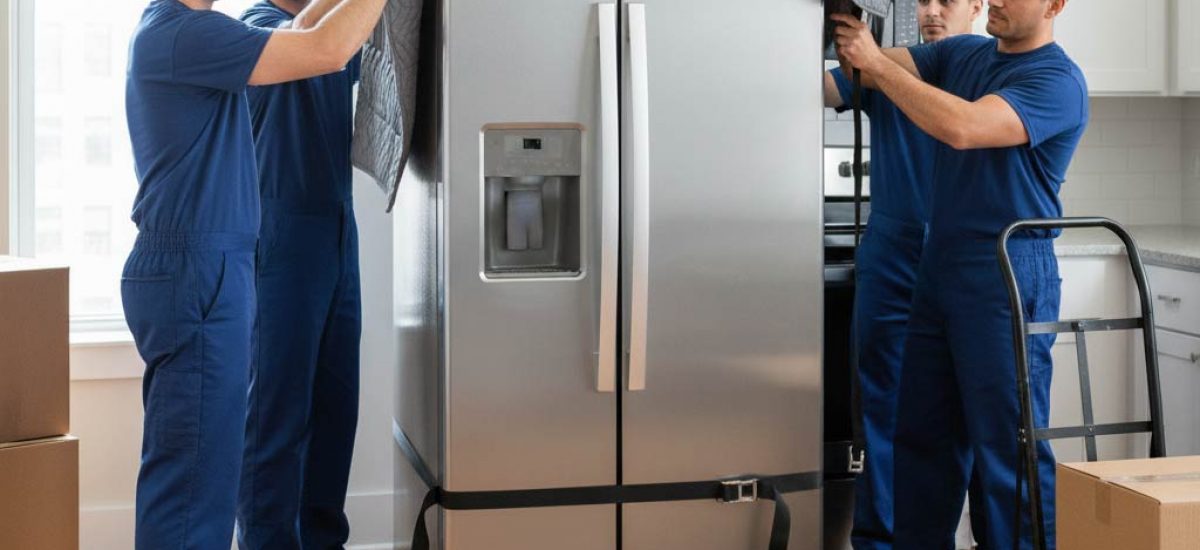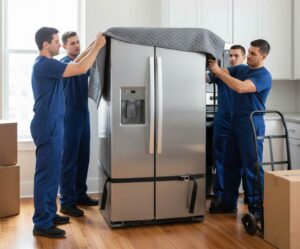Move a refrigerator not with strength, but with strategy. The appliance’s rugged exterior belies the fragility of its core sealed system; therefore, every shift of the doors, shelves, and water lines must be slow and deliberate to ensure its continued function. A few details; clearing food in a timely way, letting moisture dry out, measuring the route, and giving the compressor time to settle if the unit was tilted, tend to make the day feel steady rather than stressful. What follows is a calm plan that respects both the appliance and the home it’s leaving and entering.
Key Points
- Most manufacturers prefer an upright ride. When a tilt or side-lay is unavoidable, many models call for a short rest before power returns so compressor oil can settle; the owner’s manual lists the exact guidance.
- Moisture is the enemy of clean moves. Allowing the cabinet to dry with doors propped open keeps drips off floors and helps the interior arrive fresh.
- Width is usually the constraint, not height. A quick measure of doorways, turns, and elevator cabs clarifies whether handles or doors should come off ahead of time.
- Securing shelves, bins, and drawers prevents shifts on ramps and liftgates. Labeled bags for screws and hinge covers make reassembly straightforward.
- Floor protection pays for itself on the first threshold. Reusable runners or ram board spread weight and keep hardwood and tile in good shape.
Choosing an Approach That Fits the Space
Homes with ground-level paths and wide doorways often do well with an appliance dolly and two steady adults. Apartments and condos bring freight-elevator windows and loading zones into the picture, which adds a little scheduling but keeps the path controlled. Tight turns, long stair runs, built-in panels, or very heavy units may feel better with a professional crew that shows up with a powered dolly, liftgate truck, and padding designed for larger appliances. Any of these paths can work; the right one usually aligns with access and comfort level rather than a single rule.
Preparation Before Moving Day
A refrigerator travels best when the interior is clean and dry and the route through the home is known in advance. Many households plan meals so the contents taper off naturally, then set aside what needs to ride in a cooler on the day of the move. Water dispensers and ice makers can be paused once the interior is mostly cleared, and shut-off valves are typically behind the unit or under a nearby sink. Unplugging the appliance after that step allows the cabinet to warm slightly and release moisture, which helps shelves and drawers dry once they are removed.
Measurements reduce last-minute decisions. Door openings, hallway corners, island clearances, and elevator cab depth determine whether the refrigerator passes with handles on, with doors off, or with both removed. A short note; even a phone photo of hinge positions and connector clips makes reassembly feel calm on the other side.
Moving Day: Getting Out of the Kitchen and Into the Truck
Loose parts matter most at this stage. Glass shelves, bins, and crispers ride safely when they are wrapped together in a padded bundle or placed in a labeled carton. Light padding around the cabinet prevents scuffs, and straps on an appliance dolly keep weight centered on thresholds and ramps. Floors appreciate a protective layer; reusable runners or ram board create a continuous path that spreads weight and shields edges where tile meets wood.
Upright transport remains the baseline recommendation in most installation guides. If stairs or a low vehicle force a tilt, the refrigerator can still travel safely; it simply benefits from a settling period at the destination before power returns. The manual for the specific model remains the authority on orientation and rest times.
Should Movers Handle the Refrigerator, or Is It Better to Do It Yourself?
Either path can work; the right choice usually follows the layout of the home, the weight and style of the unit, and how comfortable you feel with door removals and water connections. Standard freestanding refrigerators in homes with ground-level access or a roomy elevator often travel smoothly with an appliance dolly and a steady two-person team. Built-ins, panel-ready models, tight stair turns, or long carries tend to feel calmer in the hands of a professional crew, sometimes even a specialist that focuses on large appliances.
| Option | When It Fits | What to Know |
|---|---|---|
| Professional movers (general household goods crew) | Freestanding units; straightforward paths; buildings that require insurance certificates and elevator scheduling. | Crews arrive with appliance dollies, pads, and straps. Many carriers disconnect but do not reconnect water lines for liability reasons; a brief check at destination confirms that no drips appear after you restore service. Valuation coverage applies to the appliance as part of the shipment; exact terms live in the paperwork. |
| Specialty appliance movers | Built-ins, panel-ready and luxury units, stair runs with tight turns, or unusually heavy models. | Teams bring powered dollies, liftgate trucks, and door-removal kits specific to high-end brands. Scheduling and price are higher, and the result is a measured pace with tools designed for weight and cabinetry clearances. |
| Handle it yourself | Ground-level homes, wide doorways, short distances, and a standard fridge with simple connections. | An appliance dolly with straps, padded corners, and a clearly measured route keep the day predictable. The owner’s manual remains the guide on transport orientation and any recommended rest before power returns. |
Buildings sometimes decide this question on your behalf. Condominium and apartment managers may ask for a certificate of insurance (COI) and specify that a licensed mover use the freight elevator during a set window; those policies make a professional crew the natural choice. In single-family homes without stairs or narrow turns, many people feel comfortable managing the move themselves and reserving outside help only when access becomes complex.
Two clarifying points help whichever route you choose: first, most movers treat water reconnection as the customer’s step, and second, a short, model-specific settling period after any tilt protects the sealed system before power comes back on. With those in mind, both professional handling and a careful do-it-yourself plan lead to the same goal—a clean, dry cabinet that lands in its new spot without drama.
Arrival and Set-Up in the New Kitchen
Placement typically leaves a little breathing room for the condenser and allows doors to swing without grazing adjacent cabinets. Leveling feet help the doors close smoothly, and a quick check for any drip at the water connection keeps floors dry. Power returns after any recommended settling period. It is normal to discard the first rounds of ice and a small amount of water from the dispenser, since new connections can carry a faint taste until the lines flush.
Helpful Gear and Materials
- An appliance dolly with strap points for a controlled ride over thresholds and on ramps.
- Reusable moving blankets and corner pads to protect finished surfaces and door edges.
- Painters’ tape and labeled zipper bags so hinges, screws, and trim pieces stay organized without sticky residue.
- Line caps for the water connection and a small towel tray for any residual drips during disconnect.
- Floor protection such as ram board or reusable runners to shield hardwood and tile along the path.
- A basic hand-tool set; nut driver, screwdriver, adjustable wrench for handle and hinge work when space is tight.
Common Pitfalls and Calmer Alternatives
- Sealing in moisture. Closing doors immediately after unplugging traps humidity and invites odors. Propping them open and letting shelves dry avoids that issue.
- Relying on friction instead of straps. Unsecured cabinets can shift on ramps; a strapped dolly carries the load without sliding and keeps hands clear.
- Forgetting the small hardware. Hinges and specialty screws are easy to misplace. A labeled bag and a quick photo of the hinge stack prevent retracing steps later.
- Powering up too soon after a tilt. A short, model-specific rest protects the compressor. The installation guide gives the exact interval.
FAQ
Do doors always need to come off?
Not always. Many kitchens allow a straight path once handles are removed. In older homes or tight apartments, taking the doors off reduces width and makes turns easier. Measurements of the narrowest point usually make the choice clear.
Is there a standard distance from the wall?
Clearance depends on venting design and model. A few inches behind the unit and some space at the top or sides are common, and the installation page for the specific refrigerator lists the exact numbers.
What happens if a small amount of water appears after reconnection?
New connections can seep until fittings seat fully. A brief snug of the connector and a dry paper towel around the joint make it easy to confirm the fix. If a slow drip persists, checking the ferrule or gasket usually resolves it.
References
- GE Appliances – Refrigerator: Moving Instructions.
- Whirlpool – How to Move a Refrigerator (includes upright/side transport and wait-time guidance).
- Samsung Support – Wait Time Before Powering a Moved Refrigerator.
- LG Support – Transporting an LG Refrigerator (upright preferred; 24-hour guidance when laid on side).
- GE Appliances – Upright & Chest Freezer: Moving Instructions (upright transport and plug-in timing).
- CDC/NIOSH – Revised NIOSH Lifting Equation (RNLE) (ergonomics context for safe handling).
- U.S. EPA – Refrigerant Safety Overview (general safety considerations around refrigerants).








